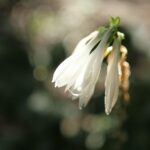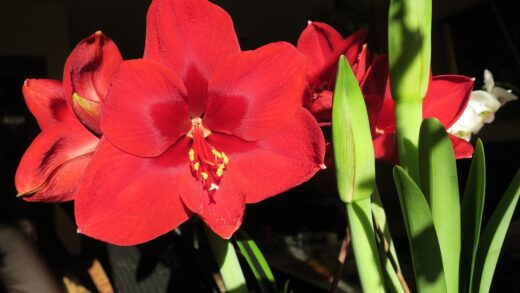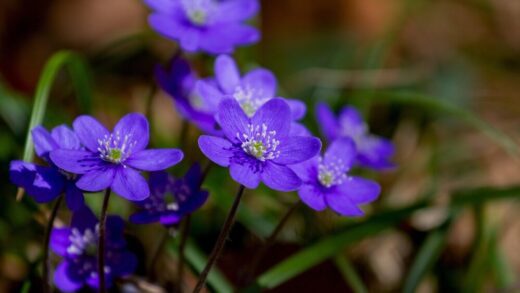Anemone hepatica is a hardy perennial, well-adapted to surviving cold winters in its native woodland habitats across the Northern Hemisphere. Its survival strategy involves a period of dormancy, where growth ceases, and the plant conserves its energy in its underground root system. In many of its native environments, a reliable blanket of snow provides crucial insulation, protecting the plant’s crown and shallow roots from the damaging effects of extreme cold, desiccating winds, and repeated freeze-thaw cycles. Successful wintering in a garden setting involves understanding these natural processes and, where necessary, replicating the protective conditions that a snow cover would naturally provide. The primary goals of winter care are to prevent root damage from freezing, protect the crown from rot, and shield any evergreen foliage from winter burn.
The preparation for winter begins long before the first frost. The care provided to the plant throughout the growing season has a direct impact on its ability to survive the winter. A plant that has been well-watered and has grown in nutrient-rich soil will have stored ample energy reserves in its roots, making it much more resilient to winter stress. It is particularly important to ensure the plant is not suffering from drought stress in the autumn, as a well-hydrated plant is better equipped to handle freezing temperatures. A final, deep watering before the ground freezes can be very beneficial if autumn rains have been scarce.
One of the most effective actions a gardener can take to prepare Anemone hepatica for winter is to apply a protective layer of mulch in the late autumn. This should be done after the first few light frosts but before the ground freezes solid. An airy, lightweight mulch that does not compact is ideal. Shredded leaves, particularly oak leaves, are an excellent choice as they mimic the natural litter of the forest floor. Pine needles or evergreen boughs are also suitable options. This mulch layer insulates the soil, moderating its temperature and preventing the heaving that can occur during freeze-thaw cycles, which can damage or expose the plant’s shallow roots.
The depth of the mulch is important; a layer of about 5-8 centimeters is generally sufficient. It is crucial to avoid piling the mulch heavily over the very center or crown of the plant, as this can trap excess moisture and lead to rot, especially during winter thaws. The mulch should be applied loosely around the plant, providing a protective blanket for the surrounding soil and roots. This simple step is the single most important aspect of actively managing the wintering process for these woodland gems.
Preparing the plant for dormancy
As autumn progresses and temperatures drop, Anemone hepatica will naturally begin to enter its dormant phase. Growth will slow and then cease. In some species and varieties, the leaves will yellow and die back to the ground, while in others, the foliage is evergreen or semi-evergreen, often taking on attractive bronze or purplish hues during the cold months. It is generally not necessary to cut back the foliage in the autumn. The persistent leaves of evergreen types can continue to photosynthesize on mild, sunny winter days, and they also provide a small amount of natural protection for the crown of the plant.
More articles on this topic
It is advisable to gently clean up the area around the plants before applying winter mulch. Removing any diseased foliage or fallen debris can help to reduce the number of overwintering sites for fungal spores and pest eggs. This basic garden hygiene is a simple but effective preventative measure that contributes to the plant’s health in the following spring. However, one should avoid vigorous raking or cultivation near the plants, which could disturb their shallow root systems just as they are preparing for winter.
Ceasing fertilization is a critical step in preparing the plant for dormancy. Fertilizing in late summer or autumn can stimulate a flush of new, tender growth that will not have time to harden off before the first hard frosts. This new growth is extremely susceptible to frost damage and can be a point of entry for diseases. The last application of any fertilizer should be no later than mid-summer, allowing the plant to naturally slow its growth in response to the changing seasons and shortening daylight hours.
The plant’s internal preparations for dormancy involve complex physiological changes. It moves sugars and nutrients from the leaves down into the root system for storage and produces compounds that act as a natural antifreeze within its cells. The gardener’s role is not to interfere with this process but to support it by providing the right external conditions: adequate autumn moisture, a clean growing area, and protection from the harshest winter elements.
Protection against winter elements
The primary winter threats to Anemone hepatica are not just the cold itself, but the combination of cold, wind, and fluctuating temperatures. In regions without reliable snow cover, the plant is exposed to these elements. Winter winds can be extremely desiccating, drawing moisture from the evergreen foliage and the soil, a phenomenon often referred to as winter burn. This is why a protective mulch is so important, as it helps to conserve soil moisture.
More articles on this topic
Freeze-thaw cycles pose another significant danger. When the ground repeatedly freezes at night and thaws during the day, the expansion and contraction of the soil can gradually push plants with shallow root systems, like Anemone hepatica, up and out of the ground. This process, known as frost heaving, exposes the delicate crown and roots to the cold, dry air, which can be fatal. A consistent layer of mulch helps to keep the soil temperature more stable, keeping it frozen during brief thaws and minimizing the risk of heaving.
In very cold climates (e.g., USDA zones 4 and colder) or in exposed, windy locations, additional protection beyond a simple leaf mulch may be warranted. Evergreen boughs, cut from Christmas trees or other conifers, can be laid over the plants after the ground has frozen. These boughs help to trap snow, further improving insulation, and they also provide a windbreak that shields the foliage from desiccating winds. They are an excellent way to provide extra protection without compacting over the plant’s crown.
For plants grown in containers, winter protection is even more critical. The soil in a pot will freeze much faster and more solidly than garden soil because it is exposed to cold air from all sides. Container-grown Anemone hepatica should be moved to a sheltered location, such as an unheated garage, a cold frame, or a protected spot against the north side of a house. The goal is to keep the roots frozen but to protect them from the most extreme temperatures and drying winds. The soil in the pot should be lightly moist, but not wet, when it freezes.
Post-winter emergence
As winter wanes and spring approaches, the gardener’s attention should return to the Anemone hepatica. The emergence of the plants is a gradual process, dictated by soil temperature. As the ground thaws, the protective winter mulch should be gently pulled back from the immediate crown of the plant. This allows sunlight and air to reach the crown, warming the soil and encouraging the plant to break dormancy. It also helps to prevent rot, which could occur if the crown remains covered by damp, heavy mulch for too long.
The rest of the mulch can be left in place around the plant, where it will continue to conserve moisture and suppress early spring weeds. Much of the decomposed leaf mulch will have already started to incorporate into the soil, adding valuable organic matter. Any coarse, un-decomposed material can be removed, or simply allowed to continue breaking down over the course of the season.
The old, overwintered leaves of evergreen varieties may look a bit tattered and weathered by early spring. It is best to wait until the new flowers and leaves begin to emerge before trimming off these old leaves. They can be carefully snipped off at the base once the new growth is well underway. This tidies the appearance of the plant and makes way for the fresh, new foliage.
The first signs of life are the flower buds pushing through the soil, often while temperatures are still quite cold. This is a critical time to ensure the soil is not overly dry, especially if the winter was lacking in precipitation. A gentle watering can help the plant as it expends a great deal of energy to produce its early spring floral display. Observing this reawakening is one of the great rewards of successfully wintering these delicate woodland plants.


















